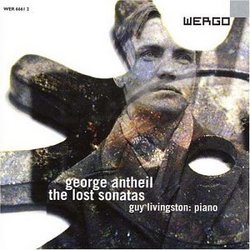| All Artists: George Antheil, Guy Livingston Title: George Antheil: The Lost Sonatas Members Wishing: 3 Total Copies: 0 Label: Wergo Germany Release Date: 11/11/2003 Album Type: Import Genre: Classical Styles: Chamber Music, Forms & Genres, Sonatas, Historical Periods, Classical (c.1770-1830), Modern, 20th, & 21st Century Number of Discs: 1 SwapaCD Credits: 1 UPC: 4010228666120 |
Search - George Antheil, Guy Livingston :: George Antheil: The Lost Sonatas
 | George Antheil, Guy Livingston George Antheil: The Lost Sonatas Genre: Classical
|
Larger Image |
CD DetailsSimilar CDs |
CD ReviewsMusical (and up-to-tempo) performances Arthur Maisel | New York, NY United States | 03/01/2004 (5 out of 5 stars) "Like those of many twentieth-century composers--including some of the better-known ones---George Antheil's works have frequently been available (when available) in poor recorded peformances. This has not always been the performers' fault: Cost of rehearsal and recording time often made impossible even the sort of performances that would be minimally acceptable if the music was by Mozart or Beethoven. In the case of Antheil's difficult music, performers' honorable desire to present unknown works in note-perfect renditions has sometimes resulted in carefully slow (not to say plodding) performances that don't give a listener any sense of the excitement the music can generate. Guy Livingston has managed not only to get all the notes (where I was able to check a score) but does so with the same musicianship that one would simply expect for more familiar music. He plays the music as if it is the greatest music ever written. Of course it isn't---but that is how a performer ought to play anything he or she takes on. It is now finally possible to begin to make a just assessment of Antheil's music." Brilliant Music D. A Wend | Buffalo Grove, IL USA | 07/22/2005 (5 out of 5 stars) "The "lost" sonatas were not truly lost but neglected. Because of the prejudice toward George Antheil's movie music his music, in general, was neglected. The sonatas were in the possession of Antheil's wife Boski, the majority in the original pencil sketches since only two sonatas had been published. George Antheil was, as his autobiography makes clear, a fabulous pianist. In his piano works he enjoyed experimenting and pushing the limits. His Fifth Sonata, first on this CD, is a true masterpiece written for pianist Frederick Marvin and was premiered by him in 1948. The sonata is based on themes by Serge Prokofiev but Antheil elaborates and extends the music. It is thought that the sonata was written as a memorial for his brother Henry, who was diplomat stationed in Russia. The sonata is very appealing and is a synthesis of his earlier and later piano music, dazzling and thoughtful. The Sonata Sauvage is very much influenced by jazz and is free form in that there is no typical development. The music just keeps going from idea to idea. The same is true of the Woman Sonata; although these two sonatas (both from 1923) can be considered futurist music with its stark contrasts, the music itself is not just a jumble of notes but has an exuberance to it that gives it appeal. The music that once provoked riots is rather tame today. The Woman Sonata has fewer percussive effects than the Sonata Sauvage and could be mistaken for music by Satie or Debussy. The Third and Fourth sonatas bring us back to the 1940's and the style of the Fifth sonata. Both works are bold, brash and highly appealing in what Antheil termed to be his neoclassical style. The music is nicely played by Guy Livingston and beautifully recorded. It took some work on Mr. Livingstone's part to incorporate the changes Antheil made to his manuscripts (and his bad handwriting) to arrive at a performing version of the sonatas. He succeeds brilliantly and has brought back George Antheil's remarkable forgotten music. As there appears to be much more unpublished music by Antheil another disc would be welcome. " Early and late Antheil piano music - an interesting overview Discophage | France | 04/19/2007 (4 out of 5 stars) "George Antheil, the (in)famous "Bad Boy of Music", appears to have been extremely careless with his own scores. Most of them remained unpublished, and the manuscripts seem to be in a state of shambles as well. Antheil probably viewed his early piano compositions as showpieces for himself only to perform, and consequently felt no need for cleaning up the manuscripts or getting them published. Then, in the late 1920s and `30s, his compositional outlook changed drastically, with a new concern for Beethovenian form and development, and he disdainfully rejected his early compositions. In his biography he calls his two Violin and Piano Sonatas from 1923 "Great Empty Chic" (they are in fact marvelously daring and fun), and the expression might be taken as a good summary of how he came to view all his early output.
These general comments have some particular relevance here. Livingston, who contributes the notes as well, provides a good general analysis of Antheil and the piano, but offers very little information on the specific works and especially the earlier ones, the circumstances of their composition, the explanation for their subtitles. Among the three works given as World premiere recordings, one is surprised to find a 1923 "Woman Sonata", that Antheil nowhere mentions in his autobiography. Well - no wonder, as it is in fact an abridged version of his 8 movement Sonata "Mechanisms". How and when it became a 3-movement "Woman Sonata", we are not told - the closest we get is when Livingston mentions that "Antheil was a notorious revisionist of his own catalog, and some works changed title, dedication, and movements several times". Benedikt Koehlen' expansive tempos gives more an impression of "infinite space" to Mechanisms (in a fine collection of Antheil's early piano works: George Antheil: Bad Boy's Piano Music) than Livingston's more nervous ones in the Woman Sonata - but it is true that the former plays movements like "Mechanism planetary", "Mechanism cubistic, "Mechanism elliptic" while the latter takes his cues from movements titled "Woman", "Tree" and "Flower": an interesting experiment in conceptual art, maybe, by which the simple change of titles entails a significant difference in the understanding of the music. Livingston does admit in the liner notes that these so-called "lost" sonatas "were never completely missing". Indeed, the "Sonata Sauvage", "Mechanisms" and Fourth Sonata have had a number of recordings, so the real recording premieres here are only the "Third" and "Fifth" Sonatas. The three late Sonatas (the so-called "Third Sonata" is from `47, the "Fourth" from 48 and the "Fifth" from `50) all sound very much like Prokofiev's War Sonatas (7th to 9th). Their outer movements are mostly motoric, forward-moving, urgent and sometimes even angry, pounding, toccata-like, but showing more concern for sonata-form and development than the early, hammering and episodic Antheil who constructed his (short) works by placing blocks with a strong melodic and rhythmic identity one after the other. They display the same kind of "bitter-sweet" harmonic turns so typical of the later Prokofiev. Livingston risks the suggestion that Antheil's grief at the tragic loss of his younger brother Henry, then an Attaché with the American ambassador in Moscow, in a plane crash in 1940, may have had to do with that Prokofiev influence. Whatever that may be, it is strange how Antheil went from one Russian to another (Stravinsky had been a major influence on the young Antheil). In the opening bars and middle movement of the Third I also hear like a secret homage to Beethoven's last Sonatas - very possible, as Antheil in is biography often avows his admiration for the German composer. But don't get me wrong: as much as they may be reminiscent of Prokofiev, these are fine compositions in their own right. Still, they are not as uniquely individual and innovative as Antheil's earlier piano compositions. Somewhere in his bio (Chap. 30) Antheil, recounting a conversation with Copland in the early 40s, pretends to be astonished at the importance given by composers (including Copland) to having a personal and recognizable "style", rather than to expressing "the form". As much as this conveys Antheil's main preoccupation of the time, I see this on his part as very much a "backlash" rejection of his former self - the brash braggadocio of the roaring Paris trying to establish his originality at any cost. Maybe his Prokofiev-style derived from a deep, inner logic and expressed his "true self" of the time. But to me, it is the young Antheil who is the incomparably original and inventive composer, the one whose music can justifiably give him a claim onto posterity. In the Sonata Sauvage Livingston is muscular and strongly articulated, but his slightly stately tempos in the fast movements and forward-moving ones in the slow ones, added to reverberant acoustics and some excessive pedalling deprive the music of some of its snap and hectic character - an important value, I feel, in playing the Bad Boy's music, and one that Koehlen applies aplenty in his above mentioned collection. The Fourth has also been recorded by Marthanne Verbit (George Antheil, Bad Boy of Music) and Eric Parkin (on a 1987 Preamble CD American Piano Music Vol.1); here Livingston, with his moderate tempos, muscular touch, crisp articulation and fine sense of dynamic contrast, brings out, better than Parkin, the music's neo-classical Stravinskysms as much as its Prokofiev march-like motorisms, and affords the music more clarity than Verbit, but less awesome power and unleashed energy at the climaxes. His forward-moving and steady approach to the middle movement is also more convincing than the excessive fussiness of his two competitors. Part of Livingston's disc overlaps Verbit's (Sonata Sauvage as well as the 4th Sonata), but its more coherent and overall interesting program makes it a preferable choice - that is, after Koehlen's collection, in my opinion the best introduction to the best part of Antheil's production for the piano. " |

 Track Listings (15) - Disc #1
Track Listings (15) - Disc #1![Spend the Day Frozen EP [Vinyl]](/images/no_cover/m.png?v=15401716)
